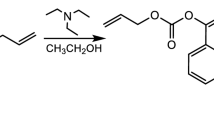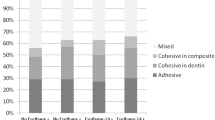Abstract
The purpose of this study was to use a three-component photoinitiation system comprising 1wt% CQ (camphorquinone), 2wt% DMAEMA (2-(dimethylamino) ethyl meth acrylate) and 2wt% Ph2I+PF6 − (diphenyliodonium hexafluorophosphate) to initiate the copolymerization of the matrix resins which combine bisphenol-S-bis (3-methacrylate-2-hydroxy propyl) ether (BisS-GMA) with the expanding monomer unsaturated spiro orthoesters 2-methylene-1,4,6-trispiro[4,4] nonane (MTOSN), for minimizing the volumetric shrinkage that generally occurs during polymerization. It was hypothesized that MTOSN would expand volumetrically during polymerization under the three-component photoinitiator system and further reductions in volumetric shrinkage would be obtained. The performance study which consists of degree of conversion and condition of the ring-opening reactions of MTOSN, volumetric shrinkage and mechanical properties including tensile bond strength, compressive strength and Vicker’s hardness were carried out respectively by Fourier transfer infrared, the dilatometer and the universal testing machine. The results supported that the dental composites based on the expanding monomer and three-component photoinitiator system engendered a greater decrease of volumetric shrinkage and better mechanical properties.
Similar content being viewed by others
References
Dewaele M, Truffier-Boutry D, Devaux J, et al. Volume Contraction in Photocured Dental Resins: The Shrinkage-conversion Relationship Revisited [J]. Dent. Mater., 2006, 22(4): 359–365
Lingois P, Berglund L. Modeling Eelastic Properties and Volume Change in Dental Composites[J]. J. Mater. Sci., 2002, 37: 4 573–4 579
Lu H, Stansbury JW, Dickens SH, et al. Probing the Origins and Control of Shrinkage Stress in Dental Resin-composites:Shrinkage Stress Characterization Technique[J]. J. Mater. Sci.: Mater. Med., 2004, 15:1 097–1 103
Lü LW, Meng GW, Liu ZH. Finite Element Analysis of Multi-piece Post-crown Restoration Using Different Types of Adhesives[J]. Int. J. Oral. Sci., 2013, 5(3):162–166
Linnu LU, Yongjia HE, Hu SG. Binding Materials of Dehydrated Phases of Waste Hardened Cement Paste and Pozzolanic Admixture [J]. Journal of Wuhan University of Technology -Materials Science Edition, 2009, 24(1):140–144
Aktas G, Sahin E, Vallittu P, et al. Effect of Colouring Green Stage Zirconia on the Adhesion of Veneering Ceramics with Different Thermal Expansion[J]. Int. J. Oral. Sci., 2013, 5(4):236–241
Calheiros FC, Sadek FT, Braga RR, et al. Polymerization Contraction Stress of Low-shrinkage Composites and Its Correlation with Microleakage in Class V Restorations [J]. J. Dent., 2004, 32(5):407–412
Versluis A, Tantbirojn D, Pintado M, et al. Residual Shrinkage Stress Distributions in Molars After Composite Restoration[J]. Dent. Mater., 2004, 20: 554–564
Watts DC, J. Schneider LF, Marghalani HY. Bond-disruptive Stresses Generated by Resin Composite Polymerizationin Dental Cavities [J]. Adhesion Science and Technology, 2009, 23:1 023–1 042
Łukaszczyk J, Janicki B, Frick A. Investigation on Synthesis and Properties of Isosorbide Based Bis-GMA Analogue[J]. J. Mater. Sci.: Mater. Med., 2012, 23:1 149–1 155
He JW, Liao LL, Liu F, et al. Synthesis and Characterization of a New Dimethacrylate Monomer based on 5,50-bis(4-hydroxylphenyl)-Hexahydro-4,7-Methanoindan for Root Canal Sealer Application[J]. J. Mater. Sci.: Mater. Med., 2010, 21: 1 135–1 142
Asmussen S, Vallo C. Characterization of Light-cured Dimethacrylate Resins Modified with Silsesquioxanes[J]. J. Mater. Sci., 2011, 46: 2 308–2 317
Kuma M, Maki Y, Ochiai B, et al. Synthesis of Copolymers Containing a Spiro Orthocarbonate Moiety and Evaluation of the Volume Change During Their Cationic Crosslinking[J]. Journal of Polymer Science: Part A: Polymer Chemistry, 2006, 44(24): 7 040–7 053
Fu J, Jia F, Xu HP, et al. Properties of a New Dental Photocurable Matrix Resin with Low Shrinkage [J]. Journal of Wuhan University of Technology-Materials Science Edition, 2010, 26(2): 236–241
Grotzinger C, Burget D, Jacques DB, et al. Visible Light Induced Photopolymerization: Speeding Up the Rate of Polymerization by Using Co-initiators in Dye/Amine Photoinitiating Systems [J]. Polymer, 2003, 44(13): 3 671–3 677
Stansburya JW, Dickens SH. Determination of Double Bond Conversion in Dental Resins by near Infrared Spectroscopy [J]. Dental Materials, 2001, 17(1): 71–79
Nishida H, Morikawa H, Nakahara T, et al. Catalytic Double Ringopening Polyaddition of Dpiro Orthoester with Acid Chloride for Shrinkage-controlled Molding [J]. Polymer, 2005, 46: 2 531–2 540
Kume M, Hirano T, Ochiai B, Endo T. Copolymers Containing a Spiro Orthoester Moiety That Undergo no Shrinkage During Cationic Crosslinking [J]. Polym. Sci. Part A Polym. Chem., 2006, 44: 3 666–3 673
Kume, M.; Endo, T. Cationic Polymerization and Crosslinking of Bicyclic Orthoesters Having Hydroxy Groups and Their Volume Change on Polymerization [J]. Network Polym. Jpn., 2004, 25:74–81
Zhou Z, Jin B, He P. Copolymerization Behavior and Kinetics of an Epoxy Copolymer with Zero Shrinkage[J]. J. Appl. Polym. Sci., 2002; 84: 1 457–1 464
Nagai D, Nishida M, Nagasawa T, et al. Non-Shrinking Networked Materials from the Cross-Linking Copolymerization of Spiroorthocarbonate with Bifunctional Oxetane[J]. Macromol Rapid Commun, 2006, 27: 921–925
Sun X, Li YC, Xiong J, et al. Shrinkage Properties of a Modified Dental Resin Composites Containing a Novel Spiro-orthocarbonate Expanding Monomer[J]. Materials letters, 2011, 65: 3 586–3 589
Emami N, Oderholm KJMS. Influence of Light-curing Procedures and Photo-initiator/co-initiator Composition on the Degree of Conversion of Light-curing Resins [J]. J. Mater. Sci.: Mater. Med., 2005, 16: 47–52
Chen Y, Li GL, Zhang HQ, et al. Visible Light Curing of Bisphenol-A epoxides and Acrylates Photoinitiated by (η6-Benzophenone)(η5-Byclopentadienyl) Iron Hexafluorophosphate[J]. J. Polym. Res., 2011, 18: 1 425–1 429
Kameyama A, Hatayama H, Kato J, et al. Light-curing of Dental Resins with GaN Violet Laser Diode: The Effect of Photoinitiator on Mechanical Strength Lasers[J]. J. Mater. Sci.: Mater. Med., 2011, 26: 279–283
Vishal S, Scranton AB. Dark-Cure Studies of Cationic Photopolymerizations of Epoxides: Characterization of the Active Center Lifetime and Kinetic Rate Constants[J]. J. Polym. Sci. Part A: Polym Chem, 2003, 41(13): 2 064–2 072
Timpe HJ, Ulrich S, Decker C, et al. Photoinitiated Polymerization of Acrylates and Methacrylates with Decahydroacridine-1, 8-dione/onium Salt Initiator Systems[J]. Macromolecules, 1993, 26(17): 4 560–4 566
Ogliari FA, Ely C, Petzhold CL, et al. Onium Salt Improves the Polymerization Kinetics in an Experimental Dental Adhesive Resin [J]. Journal of Dentistry, 2007, 35(7):583–587
Author information
Authors and Affiliations
Corresponding author
Additional information
Funded by the National Natural Science Foundation of China (No.50673065)
Rights and permissions
About this article
Cite this article
Fu, J., Liu, W., Liu, X. et al. Properties of a new dental photocurable resin based on the expanding monomer and three-component photoinitiator system. J. Wuhan Univ. Technol.-Mat. Sci. Edit. 29, 384–390 (2014). https://doi.org/10.1007/s11595-014-0926-3
Received:
Accepted:
Published:
Issue Date:
DOI: https://doi.org/10.1007/s11595-014-0926-3




